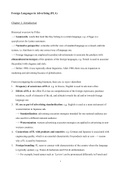Samenvatting
Foreign Languages in Advertising: Summary IBC
- Instelling
- Radboud Universiteit Nijmegen (RU)
Clear summary for the course Foreign Languages in Advertising, used in the second year of IBC at Radboud University. It contains everything you need to know for the exam, but I do recommend to also take a look at the lecture slides since they are sometimes a bit more detailled. Using this summary a...
[Meer zien]














